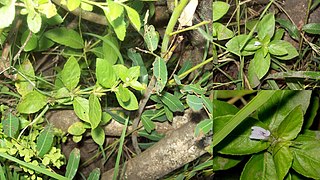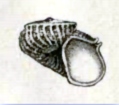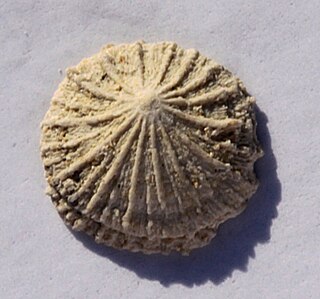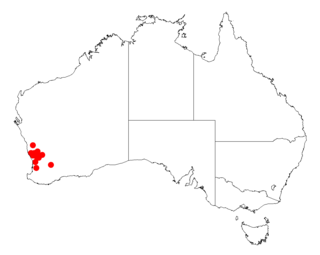
Angophora is a genus of nine species of trees and shrubs in the myrtle family, Myrtaceae. Endemic to eastern Australia, they differ from other eucalypts in having juvenile and adult leaves arranged in opposite pairs, sepals reduced to projections on the edge of the floral cup, four or five overlapping, more or less round petals, and a papery or thin, woody, often strongly ribbed capsule. Species are found between the Atherton Tableland in Queensland and south through New South Wales to eastern Victoria, Australia.

Hygrophila costata, with the common names glush weed, gulf swampweed, and yerba de hicotea, is an aquatic plant

Angophora costata, commonly known as Sydney red gum, rusty gum or smooth-barked apple, is a species of tree that is endemic to eastern Australia. Reaching 30 m (100 ft) in height, the species has distinctive smooth bark that is pinkish or orange-brown when new and fades to grey with age. Its lance-shaped leaves are arranged in opposite pairs along the stems, with white or creamy white flowers appearing from October to December. The flower buds are usually arranged in groups of three, followed by ribbed, oval or bell-shaped fruit.

Hardley Flood is a 49.8-hectare (123-acre) biological Site of Special Scientific Interest west of Great Yarmouth in Norfolk. It is part of the Broadland Ramsar site and Special Protection Area, and The Broads Special Area of Conservation.

Anisoptera costata is an endangered species of plant in the family Dipterocarpaceae. The name costata is derived from Latin and describes the prominent venation of the leaf blade. A huge emergent tree up to 65 m high, it is found in evergreen and semi-evergreen lowland tropical seasonal forests of Indo-Burma and in mixed dipterocarp forests of Malesia.

Scissurella is a genus of minute sea snails, marine gastropod molluscs in the family Scissurellidae, the small slit snails.

Elachiptera is a genus of frit flies in the family Chloropidae. There are about 18 described species in Elachiptera.

Scissurella costata is a species of minute sea snail, a marine gastropod mollusk in the family Scissurellidae.

Isocrania is an extinct genus of brachiopods found during the Upper Cretaceous. Early representatives were attached to the underground, but later species are presumed to be free living at an increasingly earlier age. This was probably an adaptation to the increasing very thick and fine sedimentation during the latest Cretaceous.

Acacia costata is a shrub belonging to the genus Acacia and the subgenus Phyllodineae that is endemic to Western Australia.

Hakea costata, commonly known as the ribbed hakea, is a shrub in the family Proteaceae native to Western Australia. A multi-stemmed small shrub producing attractive pink or white brush-like blooms rich in nectar from July to October.
Grevillea costata is a shrub of the genus Grevillea native to an area along the west coast of the Mid West region of Western Australia.

Oscinellinae is a subfamily of frit flies in the family Chloropidae. There are at least 40 genera and 180 described species in Oscinellinae.
Elachiptera nigriceps is a species of frit fly in the family Chloropidae.
Elachiptera angusta is a species of frit fly in the family Chloropidae.
Rhagodera is a genus of cylindrical bark beetles in the family Zopheridae. There are at least four described species in Rhagodera.
Elachiptera longiventris is a species of frit fly in the family Chloropidae.
Epicauta costata is a species of blister beetle in the family Meloidae. It is found in Central America and North America.
Hypasclera is a genus of false blister beetles in the family Oedemeridae. There are about 11 described species in Hypasclera.
Leptoypha costata is a species of lace bug in the family Tingidae. It is found in North America.











